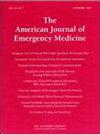美国国立卫生研究院急诊医学研究经费分析。
IF 2.2
3区 医学
Q1 EMERGENCY MEDICINE
引用次数: 0
摘要
目的:本研究的目的有三个方面。我们试图:1)确定急诊医学(EM)研究人员收到的美国国立卫生研究院(NIH)资助的总额;2)确定所获奖金在总额中的相对比例和排名;3)比较EM与神经病学、麻醉学、外科、骨科和妇产科(OBGYN)等选定专业在2006-2024年间获得的NIH资助。方法:我们对蓝岭医学研究所(BRIMR)从公开的NIH RePORTER数据库中获得的NIH资金进行了重复的横断面分析。BRIMR列出了2006年至2024年美国国立卫生研究院授予医学专业和生物医学科学的资金数额,以及每年各自的排名。确定了EM、神经病学、麻醉学、外科、骨科和OB/GYN的总金额及其相对排名,以及按年度授予的总金额的比例。结果:2006年、2007年和2008年,EM在所有专业的资金投入中排名最后,到2024年攀升至第47个百分点。每年,只有不到1%的资金拨给了EM,而神经病学的拨给率为3.40% - 5.71%。与神经病学、麻醉学、外科、骨科和妇产科相比,除了2023年和2024年外,EM在所有年份的总资助排名中都是最低的,其中只有骨科排名较低。我们的分析中不包括内科,内科每年获得的资金最多,2024年获得了53亿美元,而EM在2024年获得了1.59亿美元。结论:NIH资助在不同专业之间有很大差异。与其他与EM经常互动的专业相比,EM一直经历着非常低的NIH资助(从未超过总数的1%)。本文章由计算机程序翻译,如有差异,请以英文原文为准。
An analysis of NIH research funding in emergency medicine
Objective
The purpose of this study was threefold. We sought to: 1) determine the total dollar amount of National Institutes of Health (NIH) funding received by Emergency Medicine (EM) researchers; 2) determine the relative proportion and ranking of monies awarded compared to the total; and 3) to compare NIH funding received by EM to the select specialties of Neurology, Anesthesiology, Surgery, Orthopedics, and Obstetrics-Gynecology (OBGYN) for the years 2006–2024.
Methods
We performed a repeated cross-sectional analysis of NIH funding garnered by the Blue Ridge Institute for Medical Research (BRIMR) from the publicly available NIH RePORTER database. The BRIMR has tabulated data on the amount of NIH funding awarded to medical specialties and biomedical sciences received from 2006 to 2024, as well as their respective rankings for each year. Total dollar amount awarded to EM, Neurology, Anesthesiology, Surgery, Orthopedics, and OB/GYN and their relative rankings were identified, as was the proportion of total monies awarded by year.
Results
EM ranked last in funding compared to all specialties in 2006, 2007, and 2008 and climbed to 47th percentile by 2024. Every year, less than 1 % of funding was awarded to EM, whereas neurology was awarded 3.40 %–5.71 %. Compared to Neurology, Anesthesiology, Surgery, Orthopedics, and OB/GYN, EM ranked the lowest in total funding in all years except 2023 and 2024 in which only orthopedics ranked lower. Not included in our analysis is Internal Medicine, who received the most funding every single year, and was awarded $5.3 billion in 2024 while EM was awarded $159 million in 2024.
Conclusion
NIH funding varies substantially between specialties. EM has consistently experienced very low NIH funding (never exceeding 1 % of total) compared to other specialties with which they commonly interact.
求助全文
通过发布文献求助,成功后即可免费获取论文全文。
去求助
来源期刊
CiteScore
6.00
自引率
5.60%
发文量
730
审稿时长
42 days
期刊介绍:
A distinctive blend of practicality and scholarliness makes the American Journal of Emergency Medicine a key source for information on emergency medical care. Covering all activities concerned with emergency medicine, it is the journal to turn to for information to help increase the ability to understand, recognize and treat emergency conditions. Issues contain clinical articles, case reports, review articles, editorials, international notes, book reviews and more.

 求助内容:
求助内容: 应助结果提醒方式:
应助结果提醒方式:


